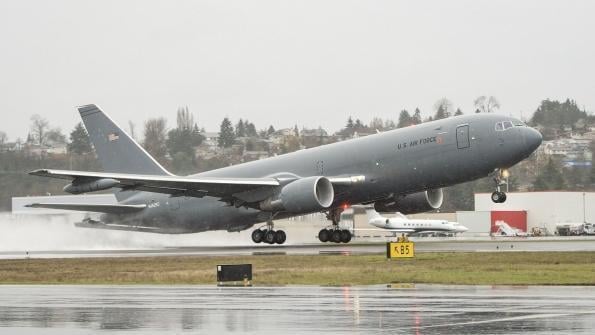
The U.S. Air Force has cleared its Boeing KC-46 tanker for worldwide deployments, even though the aircraft is still years away from being considered operational.
The service announced Sept. 19 that following a deployment of tankers to the Middle East, during which the aircraft performed its first operationally tasked combat refueling, the tanker is ready to be used “without hesitation,” though there are multiple caveats.
“We’ve got 60-plus of those KC-46s right now. It’s incredibly capable. It certainly had some challenges that we have to work forward,” Air Mobility Command Gen. Mike Minihan told reporters Sept. 19. “The crews are adjusting tactics techniques and procedures to employ it at a high capability, but there’s still things that need to be addressed.”
The decision is the last step in an Interim Capability Release plan, first outlined in the summer of 2021, that allows the tanker to be tasked by U.S. Transportation Command for operational missions. Minihan on Sept. 14 approved the last receivers to be refueled under this plan.
The tanker still has a series of deficiencies with its Remote Vision System—the collection of cameras and sensors that a boom operator in the front of the aircraft uses to pass fuel to receiving aircraft. The system, including the entire operator station in the aircraft, will be replaced as part of the Remote Vision System 2.0 design. The plan is still in critical design review, as the Air Force and Boeing hammer out a schedule for the fixes. A separate problem with the boom itself that prevents it from connecting to slower-moving aircraft such as the A-10 also needs to be fixed on the Air Force’s dime.
These fixes are currently scheduled to begin in 2024, and the service expects initial operational capability to follow.
The AMC decision to provide the tanker to global combatant commanders avoids the original operational plan, and Minihan says he made the choice because of the need to have the tanker available.
“I need it now. I am extremely straightforward with Boeing on my concerns about quality, timelines, and costs, OK? But, if I can put an incredibly capable tanker in the fight, then why wouldn’t I? OK. America demands it, the DOD demands it, and everybody that’s going to be a customer of that platform demands it,” Minihan says. “… It’s the most capable aircraft in my inventory right now. It already is making an enormous impact. There are 60 in the fleet, and I would not for one second play politics with the defense industry when it comes to the mission of my command or the lives of Americans I support.”
With the deficiencies, such as problems with shadows or washed out images in certain settings, crews are still using work-arounds such as changing the angles of refueling tracks. RVS 2.0 will fix that, Minihan says.
